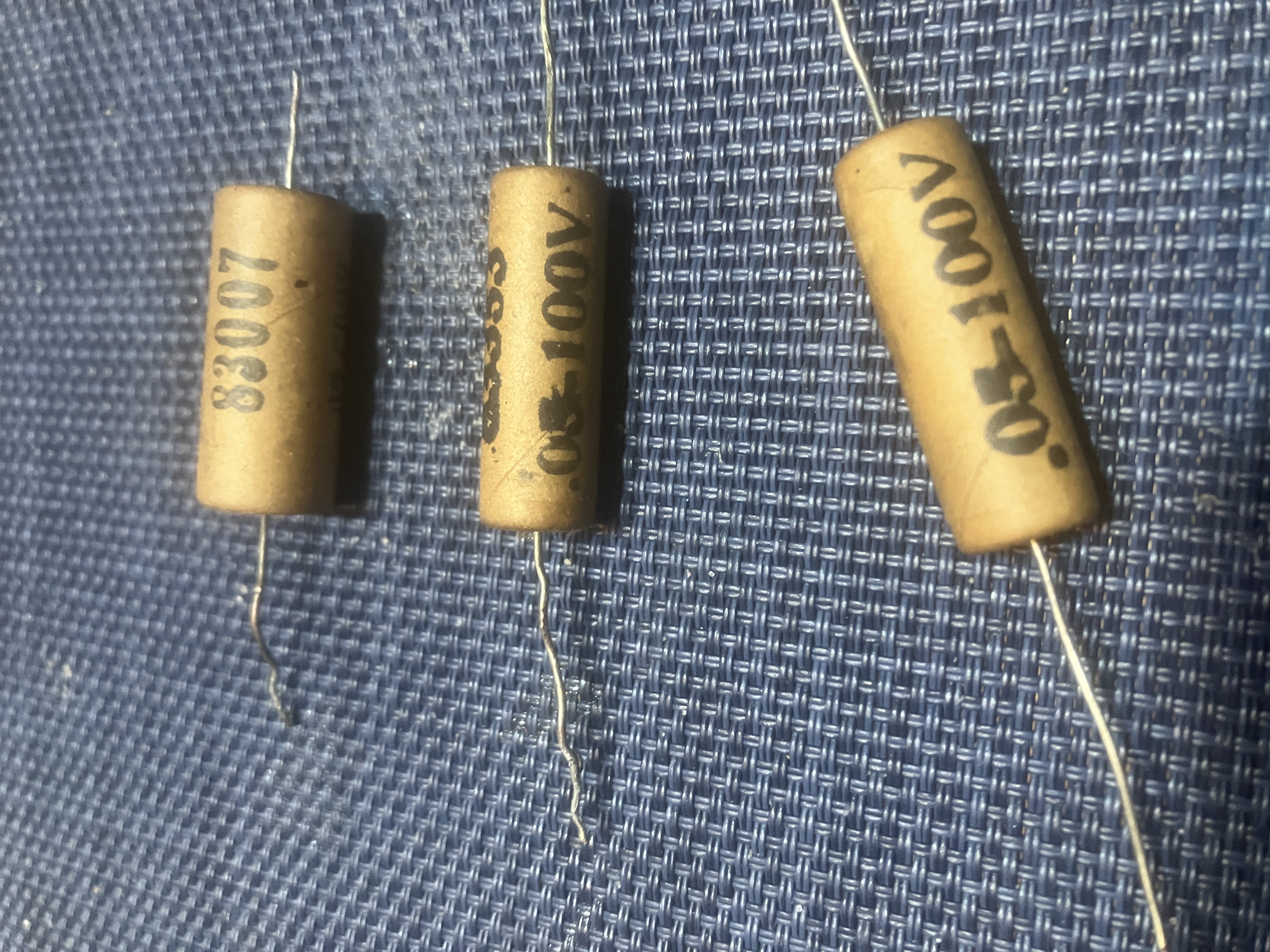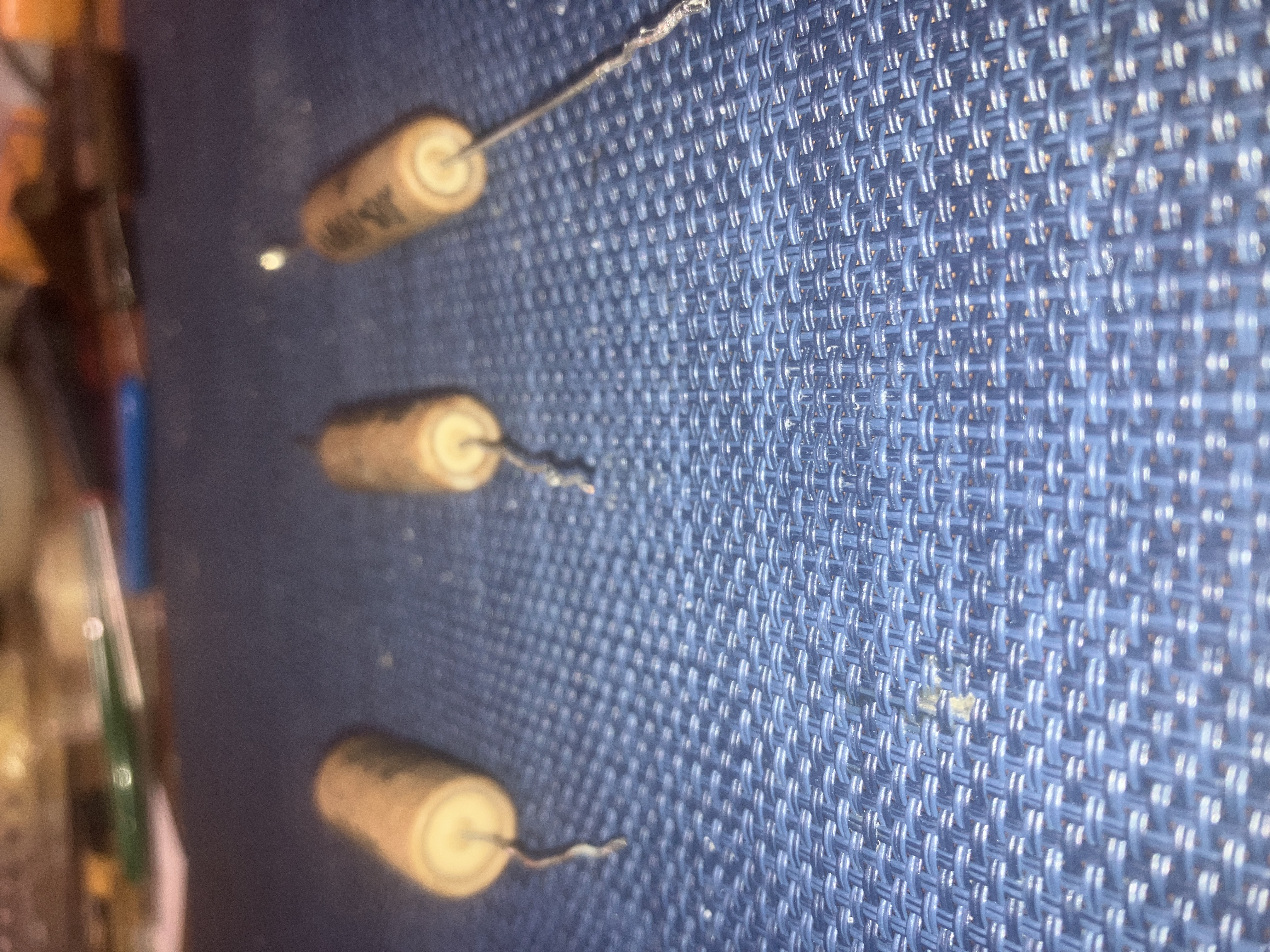Were there other kinds of capacitors in 1934 other than the old Wax Paper Capacitors?
Posts: 325
Threads: 34
Joined: Dec 2019
City: Elkhart
State, Province, Country: Indiana
Hello everyone, I was replacing the original capacitors from my 1934 Stewart-Warner Tombstone Radio the other day and I noticed that the original Coupling Capacitors in the radio seemed to be of a better quality than the usual "waxies" you find in other radios from the same time period, as the ends of the capacitors in this radio were plugged with cardboard endplugs rather than the usual wax endplugs. Were there other types of capacitors in the 1930s besides the wax coated paper caps that you usually tended to see in radios from this time period and were they a better quality capacitor than the usual wax coated types, were these maybe oil caps of some sort? I haven't had a chance to test them to see if they were leaky or not but the physical condition of these caps is like brand new yet, nothing leaking out of the ends or anything, the only thing physically wrong with some of them is that the cardboard tubing has been darkened over the years due to being near some high wattage resistors that put out enough heat to discolor the cardboard tubes and also being near the 2A5 tubes that also get pretty hot, because they seem to be driving them to their limit voltage wise.


Posts: 1,288
Threads: 11
Joined: Jul 2020
City: Greenlawn
State, Province, Country: NY
Hi Captain Clock,
RCA used caps like these in some of their radios. I have 2 RCA Farm sets ca 1936 that used caps like these. pop out the disk and you will see some sort of gloppy cap that was essentially a foil / wax cap without the paper
The paper disks do pop put relatively easily. If the caps are still in the radio, slide the tube as far as you can, cut the cap (capacitor) lead at the "gumdrop" (or other amorphous shape). Do the same to the other side. Slide in the new cap which will be smaller than what you are replacing. Solder to the existing leads, reassemble and there will be no evidence that you changed the cap.
"Do Justly, love Mercy and walk humbly with your God"- Micah 6:8
"Let us begin to do good"- St. Francis
Best Regards,
MrFixr55
Posts: 325
Threads: 34
Joined: Dec 2019
City: Elkhart
State, Province, Country: Indiana
OK, Interesting, I didn't realize these were used by other companies as well, I've only seen this style of caps in one or two other radios I've worked on over the years, an old Battery Powered Farm Radio from 1937 and an old Westinghouse Columnette Tombstone Radio from 1935. So by the sounds of it these might of been early Oil Capacitors?
Posts: 4,949
Threads: 54
Joined: Sep 2008
City: Sandwick, BC, CA
I don't know about the caps used in this Stewart Warner, but with the ones used in RCA and G.E sets you can get the old cap out by placing a suitably sized mechanic's socket on on a table or bench, place the end of the capacitor down over the socket, grasp the paper tube, and push down, the cap will pop out of the end opposite.
Regards
Arran
(This post was last modified: 01-08-2025, 12:28 AM by Arran.)
Posts: 1,288
Threads: 11
Joined: Jul 2020
City: Greenlawn
State, Province, Country: NY
Captain Clock, I did not cut up the innards of the caps, but I don't think that they are oil. The paper in most tubular caps may have an oil coating, but I don't think of those as "oil" caps in the sense of the original oil filled caps that are hermetically sealed.
Early 1930s Westinghouse Columnette radios were built by RCA. The original floor standing Columnette clock radio being an RCA Radiola 80. I don't know when Westinghouse started building their own radios or stopped using RCA, maybe between 1933 and 1935, but even into the late 1930s some Westinghouse sets were built by other companies. I have only 2 Westinghouse radios in my collection, A WR211 ca 1935-37 made by American Bosch, and a WR217, also ca 1936-37 which used an Emerson R series chassis. I think that some of the H series Westinghouse radios were built by them.
"Do Justly, love Mercy and walk humbly with your God"- Micah 6:8
"Let us begin to do good"- St. Francis
Best Regards,
MrFixr55
Posts: 325
Threads: 34
Joined: Dec 2019
City: Elkhart
State, Province, Country: Indiana
OK I wasn't sure, I was just asking because these capacitors look like they are of significantly better build quality than some of the capacitors of other companies from that time period (specifically companies like Good-All, and Seal-Tite.)
Posts: 4,949
Threads: 54
Joined: Sep 2008
City: Sandwick, BC, CA
The Solar Sealtite ones, at least the ones encased in molded wax from the 1940s, seem to hold up better then most other makes from that era. Sprague paper caps are another that seem to hold up better then others, but given the age of all of these you can't trust them if there is a high voltage potential across them. Canadian Westinghouse was run a bit differently then the U.S company, they actually built most of their own sets, though likely under license. The Columnaire they built in Canada was called a model 801, and they used a similar circuit to an RCA R7 Nipperette, but was mechanically different in both the clock model, and the more conventional models, the biggest difference was that they had the tuning condenser mounted on top of the chassis across the front. In those sets they didn't use as many tubular paper capacitors, and where they did they didn't have the rolled over ends. The filter caps were so called "Dry electrolytics" mounted in a square metal box on top of the chassis. I think the oldest RCA and G.E sets I saw with the caps with the rolled over ends was maybe 1936, and they were using them right up until the war, as I mentioned they are fairly easy to get the innards out of and restuff, no heat gun or toaster oven needed.
Regards
Arran
Users browsing this thread:
|
|
Recent Posts
|
|
Philco 42-345 Restoration/Repair
|
| Vlad95,
Thank you for the stringing guides and wow there are so manyosanders0311 — 06:01 PM |
|
5U4 vs 5Z4 tubes
|
| A pre war Hallicrafters, and an early one too, very nice! 1936 is pretty early for metal tubes too, which would explain ...Arran — 05:58 PM |
|
Philco 42-345 Restoration/Repair
|
| Thanks Rod,
"When you hear the background hiss and no station it usually indicates that the oscillator quit" ...osanders0311 — 05:52 PM |
|
Philco 42-345 Restoration/Repair
|
| RodB
:beerchug:Vlad95 — 10:22 AM |
|
Philco 42-345 Restoration/Repair
|
| Vlad, you nailed it. Swiss and German roots.RodB — 09:54 AM |
|
5U4 vs 5Z4 tubes
|
| Well this is a Hallicrafters SX/9 circa 1936.
No real issues so far although I dodged a real bullet with a cap that was...bridkarl — 07:59 AM |
|
5U4 vs 5Z4 tubes
|
| The pinout is the same but the 5U4 has a 3 amp filament, verses 2 amps or less on the 5Z4. I think that the pinout of a ...Arran — 12:04 AM |
|
Philco 42-345 Restoration/Repair
|
| By the way.
osanders0311
Take a look here: Dial cord stringing Guides
May be here you can fount correct string settin...Vlad95 — 11:15 PM |
|
5U4 vs 5Z4 tubes
|
| 5U4 and 5Z4 almost identical. I think nothing happened if you left 5U4 instedad 5Z4 long time.
Just heater current 5U4 ...Vlad95 — 11:02 PM |
|
Philco 42-345 Restoration/Repair
|
| Hello Vlad95 ,
Very Funny !
Sincerely Richardradiorich — 11:01 PM |
|
Who's Online
|
| There are currently no members online. |

|
 
|





![[-] [-]](https://philcoradio.com/phorum/images/bootbb/collapse.png)


